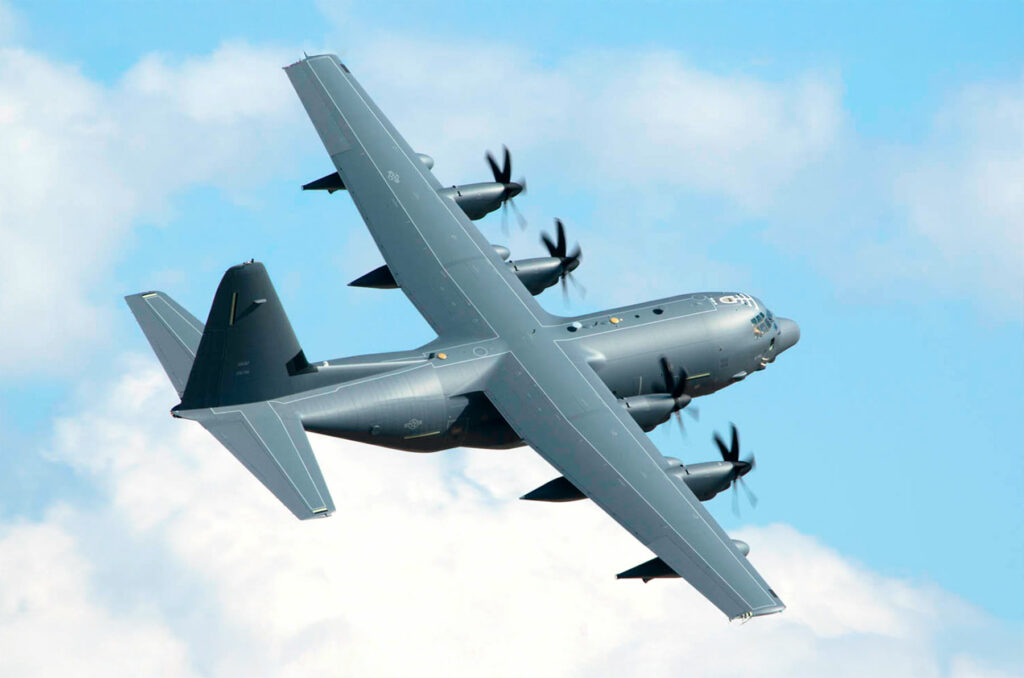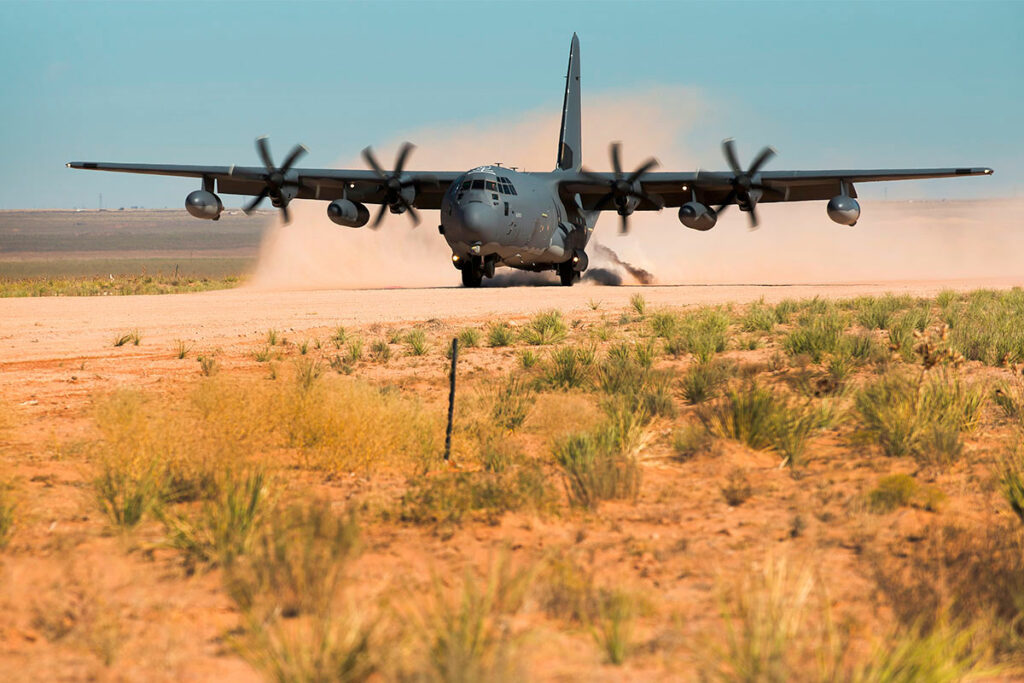Lockheed MC-130J Commando II: A versatile, multi-mission special ops tanker and transport aircraft for refueling, infiltration, and resupply.
In brief
The Lockheed MC-130J Commando II is a specialized tanker and transport aircraft built to meet the rigorous demands of special operations. Derived from the C-130J Super Hercules, it features advanced avionics, reinforced wings, and powerful turboprop engines. The Commando II has a maximum takeoff weight of 74,389 kg (164,000 lbs) and operates at altitudes up to 28,000 feet (8,535 meters) with a range of 4,828 km (3,000 miles). It is powered by four Rolls-Royce AE 2100D3 engines, each delivering 4,591 horsepower, driving six-blade composite propellers for high-efficiency, low-noise operation. Designed for low-level flight, it has specialized systems for terrain-following navigation and operates in hostile environments, supporting refueling, troop transport, and supply drops for special operations forces globally.

The Lockheed MC-130J Commando II
As a key asset for AFSOC, the MC-130J Commando II enhances mission versatility by enabling in-flight refueling of helicopters and tilt-rotor aircraft, performing critical tactical airlift, and conducting aerial refueling at low altitudes. Developed as part of Lockheed Martin’s C-130 family, it serves as a multi-role platform capable of covert operations in contested regions. Enhanced by its sophisticated avionics and extended range, the MC-130J supports critical missions involving clandestine insertions, equipment delivery, and fuel transfers to forward-deployed forces, often in remote areas lacking traditional runway infrastructure.
History of Development
The need for a specialized tanker and transport aircraft for special operations led to the development of the MC-130J. In the early 2000s, the U.S. Air Force sought to modernize its fleet, aiming to replace aging MC-130 models like the MC-130E/P that had served since the Vietnam War. The MC-130J development program began in 2008 when Lockheed Martin received a contract to design an advanced aircraft based on the C-130J Super Hercules airframe. The MC-130J was officially introduced after its maiden flight on July 29, 2010. Known as “Commando II” by NATO designation, it drew on decades of experience with the C-130 series to deliver robust capabilities tailored for the unique requirements of special operations forces (SOF).
The Commando II entered operational service in 2011 with AFSOC. It was built with the capacity to perform refueling operations, personnel transport, and equipment deployment across harsh terrains without support infrastructure. Over its development phase, key upgrades included navigation, advanced radar systems, and hardened airframes to withstand austere conditions. In 2012, after its successful deployment and evaluation, the MC-130J began full operational capability, replacing older variants within the U.S. Air Force’s special operations squadrons. The aircraft supports multiple SOF missions globally, fulfilling the need for an adaptable, durable, and efficient platform.
Design
The MC-130J Commando II’s design builds upon the KC-130J tanker’s structure, with specific enhancements for special operations. Its four AE 2100D3 turboprops generate sufficient power for low-altitude operations, providing speeds up to 416 mph (670 km/h). The reinforced airframe includes multi-functional displays, a terrain-following radar, and GPS/inertial navigation systems, enabling flight under challenging weather and at night. At 29.8 meters (97.8 feet) in length with a wingspan of 40.4 meters (132.5 feet), it is large yet compact enough to manage shorter, unprepared runways.
Its payload bay can transport equipment, personnel, or refueling tanks, while two additional external fuel tanks extend its operational range. This flexibility allows the Commando II to perform both personnel and equipment transport and covert insertion/extraction missions.
Performance
The MC-130J Commando II’s four Rolls-Royce AE 2100D3 engines, each delivering 4,591 hp, allow it to reach speeds up to 415 mph (670 km/h) and altitudes of 28,000 feet (8,535 meters). With an operational range of 4,828 km (3,000 miles), it can support extended-range missions without the need for in-flight refueling. Its maximum takeoff weight stands at 74,400 kg (164,000 lbs), allowing it to carry substantial cargo or refueling supplies. This range and endurance make it suitable for supporting remote operations in regions where traditional logistics are unavailable.
The Commando II also features advanced electronic and communication systems that secure data transmission, making it an effective intelligence and support aircraft. It supports inflight refueling operations for special operations helicopters, enhancing SOF mobility and endurance for extended missions.
Variants
The MC-130J Commando II serves as the primary model within this specialized fleet. However, there are closely related variants developed for distinct mission profiles. The MC-130H Combat Talon II and MC-130W Dragon Spear are earlier SOF variants used before the Commando II’s introduction. While similar, these older models lack some of the advanced capabilities of the MC-130J, such as updated avionics and improved radar systems.

Military Use and Combat
The MC-130J Commando II has become a critical asset for U.S. Special Operations Forces (SOF), providing advanced capabilities that enable complex missions in hostile and remote areas. Designed by Lockheed Martin, the aircraft combines advanced in-flight refueling with strategic airlift and intelligence capabilities, making it essential for operations in active combat zones and sensitive regions.
Key Operations and Role in Combat Zones
The MC-130J supports missions such as low-level in-flight refueling, covert infiltration, exfiltration, and resupply of SOF units, and it is particularly valuable in regions where conventional refueling or logistics are not possible. In Iraq, Afghanistan, and Syria, the Commando II has been deployed to refuel helicopters and tilt-rotor aircraft, including the CV-22 Osprey, in mid-air, allowing SOF assets to extend their range without returning to base. This capability has proven vital for supporting prolonged operations in areas with limited air support options and minimal infrastructure, such as forward operating bases or temporary mission outposts.
The MC-130J’s ability to operate from austere, short airfields expands its mission flexibility. Its advanced avionics, including terrain-following radar and Electro-Optical/Infrared (EO/IR) systems, allow it to navigate low-altitude flight paths even in adverse weather conditions. These features make it possible for the MC-130J to approach and depart from covert locations with minimal detection risk, adding a level of discretion necessary for sensitive SOF missions.
In-Flight Refueling and Strategic Reach
One of the defining features of the MC-130J Commando II is its low-level refueling capability. Unlike conventional tankers, which generally operate at higher altitudes, the Commando II can refuel SOF aircraft in challenging terrain and low-visibility environments. This unique capability is critical for rotary and tilt-rotor assets like the MH-60 Black Hawk and the V-22 Osprey, enabling them to conduct missions further from established bases. The MC-130J extends the operational range of these assets, allowing SOF units to conduct deep insertion missions, reconnaissance, and quick-reaction force deployments without the logistical constraints of fixed bases.
During Operation Inherent Resolve in Syria, the MC-130J provided crucial support for coalition forces conducting airstrikes and ground operations against hostile forces. Its ability to refuel attack and transport helicopters kept SOF teams operational for extended periods, even as they engaged in dynamic combat scenarios. The Commando II’s aerial refueling ensured that critical assets like AH-64 Apache helicopters had the fuel necessary to provide close air support and protection to ground forces.
Precision Air Drops and Covert Insertion
Beyond refueling, the MC-130J also enables air drops in challenging environments, delivering supplies and personnel with pinpoint accuracy. These precision air drops are often conducted under cover of darkness to supply ground forces with ammunition, medical supplies, and other essential equipment. In mountainous regions, such as those encountered in Afghanistan, the MC-130J has demonstrated its ability to accurately deliver supplies to forces in hard-to-reach locations.
The Commando II’s advanced avionics allow it to perform these tasks discreetly, minimizing the likelihood of detection. This capability is essential for special operations units operating near hostile territories where maintaining operational secrecy is vital for mission success. In high-risk zones, the MC-130J’s ability to execute low-level, high-precision air drops provides an edge for SOF units who rely on timely resupply in active combat situations.
Combat Extraction and Personnel Recovery
In addition to supply drops, the MC-130J supports combat extractions and personnel recovery missions. These missions are particularly challenging in contested zones, where the extraction of personnel can expose both the aircraft and ground units to enemy detection and fire. Equipped with countermeasure systems and SATCOM-linked communications, the MC-130J can extract personnel from hot zones, often under hostile fire, making it invaluable for recovery operations.
During a classified mission in the Middle East, the MC-130J played a pivotal role in recovering downed personnel. The aircraft’s low-level flying capabilities allowed it to approach the recovery zone without alerting enemy forces. The advanced communications systems enabled real-time coordination with ground teams, while the terrain-following radar ensured safe navigation despite challenging topography.
Electronic Warfare and Data Transmission
The MC-130J’s role extends beyond transport and refueling. It is equipped with sophisticated electronic warfare (EW) capabilities and secure communications links, enabling real-time intelligence gathering and data transmission. These systems allow the Commando II to serve as a communications relay, providing continuous connectivity for SOF teams operating in remote areas. This capability ensures that SOF teams maintain situational awareness and can rapidly adapt to changes in mission dynamics.
In Afghanistan, the MC-130J served as a communications node, relaying critical intelligence to teams operating in mountainous regions where direct communication with command centers was challenging. The aircraft’s SATCOM systems provided uninterrupted data flow, keeping the command structure informed and allowing for rapid decision-making as missions evolved. The Commando II’s EW capabilities also serve as a deterrent, allowing it to counter radar and infrared threats, further enhancing its survivability and mission effectiveness.
Role in Training and SOF Mission Support
The MC-130J not only supports active missions but also plays a crucial role in the training of SOF units. It is integrated into joint exercises with other special operations platforms to prepare SOF teams for multi-domain combat scenarios. This training includes practicing inflight refueling under simulated combat conditions, precision air drops, and covert insertions. Training exercises with the Commando II have enhanced SOF readiness, ensuring that personnel are familiar with the tactical advantages provided by the aircraft in real-world operations.
At Kirtland Air Force Base, the MC-130J serves as part of a dedicated training fleet, preparing AFSOC airmen for the demands of special operations missions. By providing realistic training environments, the Commando II enables SOF units to refine their skills in using aerial refueling, combat insertion, and personnel recovery tactics effectively. These exercises, often conducted with other SOF aircraft like the MH-60 Black Hawk and V-22 Osprey, simulate complex, multi-tiered missions that require precise timing and seamless coordination among various assets.
Global Reach and Future Potential
As the MC-130J continues to support SOF missions globally, its role is expected to expand with technological upgrades. Current upgrades include enhanced EW systems and potential armament options for future missions, which would allow the Commando II to perform strike capabilities, adding to its already extensive mission profile. The MC-130J’s deployment to U.S. bases in Europe and Asia demonstrates its strategic importance, as it offers rapid response capabilities that are vital for SOF operations worldwide.
Back to the Special Aircraft section